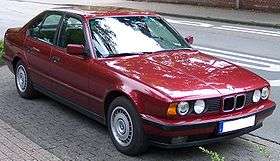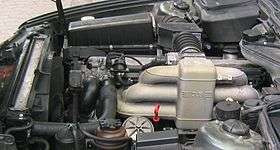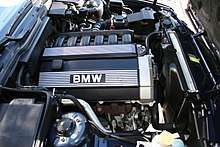BMW 5 Series (E34)
| BMW 5 Series (E34) | |
|---|---|
 | |
| Overview | |
| Manufacturer | BMW |
| Production | 1987–1996 |
| Assembly |
Germany: Dingolfing South Africa: Rosslyn[1] |
| Designer |
Claus Luthe Ercole Spada J Mays |
| Body and chassis | |
| Class | Executive car (E)[2] |
| Body style |
4-door saloon 5-door estate |
| Layout |
FR layout (most models) F4 layout (525iX only) |
| Powertrain | |
| Engine |
Petrol: 1.8 L M40 I4 1.8 L M43 I4 2.0-2.5 L M20 I6 2.0-2.5 L M50 I6 3.0-3.4 L M30 I6 3.5-3.8 L S38 I6 3.0-4.0 L M60 V8 Diesel: 2.4 L M21 turbo I6 2.5 L M51 turbo I6 |
| Dimensions | |
| Wheelbase | 2,760 mm (109 in)[3] |
| Length | 4,720 mm (186 in)[4] |
| Width | 1,750 mm (69 in)[4] |
| Height | 1,420 mm (56 in)[5] |
| Curb weight | 1,440–1,800 kg (3,170–3,970 lb)[6][7] |
| Chronology | |
| Predecessor | BMW 5 Series (E28) |
| Successor | BMW 5 Series (E39) |
The BMW E34 is the third generation of the BMW 5 Series, which was produced from the 2nd of November 1987 until June 1996.[8][9] It was launched in the sedan body style, with the range expanded in 1990 to include the "Touring" wagon (estate) body style. The E34 was replaced by the E39 in December 1995, although E34 Touring models remained in production until June 1996.
The E34 was the first 5 Series to be available with the wagon body style, the 525iX was the first 5 Series with all-wheel drive and V8 engines were also first available in a 5 Series during the E34 generation. It also saw the introduction of stability control (ASC), traction control (ASC+T) a 6-speed manual transmission and adjustable damping (EDC) to the 5 Series range.
There was an unusually large range of engines fitted over its lifetime, as nine different engine families were used. These consisted of 4-cylinder, straight-six and V8 engines.
The E34 M5 is powered by the S38 straight-six engine and was produced in sedan and wagon body styles.
Development and production
Development ran from July 1981 to early 1987, with the initial design proposal penned by Ercole Spada in 1982.[10] Under the guidance of chief designer Claus Luthe, BMW based much of the design on the E32 7 Series. Following Spada's departure from BMW and styling approval in 1983, J Mays finalized the design for production in mid-1985. In December 1987, the E34 sedan was unveiled to global press.[11][12] Special attention was paid to aerodynamics, with the E34 having a drag coefficient of 0.30.[13]
Production of the E34 commenced on November 2, 1987 for the 535i, with 535i market launch being in January 1988 and other variants following a staggered launch. 520i and 530i production began in January 1988, for March 1988 market launch. Production of the 525i began in February 1988, being launched to market in April 1988, with the 524td entering production in March 1988 for May 1988 introduction. Touring production began in July 1992, after presentation at IAA 1991. Production ended for the sedan in December 1995 and Touring in June 1996, with 1,333,412 units being built in total.[14][15]
Body styles
_(cropped).jpg) E34 sedan
E34 sedan_Touring_station_wagon_(2015-07-24).jpg) E34 Touring
E34 Touring
Models
518i
Base model, available only in Europe.[16] It uses a 4-cylinder engine: initially the M40, which was replaced by the M43 in 1994. The 518i was available in sedan or wagon body styles, however the only transmission available was a 5-speed manual.[17]
520i
The lowest 6-cylinder model and the base model E34 in some countries. Initial production of the 520i started in January 1988, using the single-cam M20 engine. In 1990, the M20 was replaced by the twin-cam M50 engine. A further revision of the 520i engine took place in September 1992, when the updated M50 engine (called "M50TU") introduced VANOS (variable valve timing). The M50 version of the 520i was the most popular variant sold in Europe and the 520i was the second most popular E34 model globally, with 436,108 units produced.
525i
A mid-range model which used a 6-cylinder engine. Like the 520i, the 525i was initially powered by the M20 engine, which was later updated to the M50 and M50TU engines. The 525i was the most popular E34 model globally, with 566,573 units produced.
525iX
The 525iX was the first all-wheel drive 5 Series, and the only all-wheel drive model in the E34 range. It was powered by the M50 engine and available in both sedan and wagon body styles. The centre differential normally would divide 36% torque to the front axle and 64% to the rear axle, but could adjust the ratio according to driving conditions in case wheels of one of the axles started to slip. Only 9,366 cars were produced.[18]
530i
There are two versions of the 530i, a 6-cylinder model which was produced from 1988 to 1990 and a V8 model produced from 1992 to 1995. The earlier 6-cylinder model was powered by the M30 and not sold in North America. The V8 version, which effectively replaced the 6-cylinder 535i in the line-up, was powered by the new M60 engine and was available in sedan and wagon body styles. Transmission choices for the V8 version were a 5-speed manual and a 5-speed automatic.[16] Initially, the V8 models were differentiated by the wide grills (until 1994, when the wide grills became available on other models).
535i

During its production from November 1987 to 1992, the 6-cylinder 535i was the top model in the regular E34 line-up. A total of 126,895 535i cars were produced, including 6,469 were sold in North America. The 535i was replaced by the V8 engined 530i and 540i models.
Despite the 535i designation and '3.5' casting on the intake manifold, the M30 6-cylinder engine found in the E34 535i was actually 3.4 litres (207 cu in).
540i
In 1992, the 540i model was added at the top of the E34 line-up, using the M60 V8 engine. It was available in both sedan and wagon body styles (the latter not in US). The transmission options were a 6-speed manual transmission (offered from 1994 to 1995 in North America for MY 1995, and from 1993 to 1996 in Europe) or a 5-speed automatic. Only 3,203 units of the manual 540i were produced. Initially, the V8 models were differentiated by the wide grills (until 1994, when the wide grills became available on other models).
North American model range
The E34 range was launched in October 1988 in North America with the 525i and 535i 6-cylinder models for the 1989 MY.[19] Over the course of the E34 generation, the 525i Touring, 530i, 530i Touring, 540i and M5 models were sold in North America. Each model was released earlier in Europe than in North America.
M5 version
.jpg)
Introduced in September 1988[20] and produced until August 1995, the E34 M5 was produced in both sedan and Touring body styles, a first for the badge.
The E34 M5 is powered by the S38 straight-6 engine, originally with a displacement of 3.6 L (220 cu in) and an output of 232 kW (311 hp), later upgraded to a 3.8 L (232 cu in) engine producing 250 kW (340 PS; 335 hp). This 3.8 litre version of the M5 was first seen by the public at the 1991 Frankfurt Motor Show, where the E34 M5 Touring also saw its debut.[20]
In its last year of production BMW used the Getrag 420G 6-speed manual gearbox, which was also used in the 8 Series and the 540i, as well as the subsequent E39 5er.
Special models
518g
A model which could run on natural gas (as well as petrol) and was only sold in Germany. The 518g was based on the 518i wagon and the only transmission available was a 5-speed manual.[21] When running on natural gas, the engine produced 73 kW (98 hp),[22] compared with 84 kW (113 hp) when running on petrol. It was only produced in 1995 and just 298 units were built.
518iev prototype
After unveiling the BMW E1 and E2 Electric Vehicles (EVs) in 1992, BMW began a project to show it was possible to make full-sized electric car, something few others would countenance due to the weight of the battery technology at the time. To make it possible despite the lead-based batteries, the 518iev,[23] had a modified 4 cylinder drive-line fitted with CVT, battery packs and ground-breaking rotating-field AC electric drive. This configuration was the predecessor of present-day EV Hybrids. BMW built at least one fully functional e34 prototype; however, very little was recorded about it that exists online. Extensive testing of this (and many others) in the late nineties was carried out with partners such as Deutsche Post, however the company did not utilise improvements in battery technology in the years following to advance electric technology in production until BMW announced ActiveE prototypes in 2010 (preceding the BMW i3 and i8) and 'Efficient Dynamics' models.
540i M-sport / M540i / 540i LE
.jpg)
Because the M5 was discontinued for non-European markets in 1993, the 540i M-Sport model was built in 1995 for the North American market.[24] On top of the regular 540i features, additional features included sports suspension equipped with EDC, bolstered sport seats, servotronic steering, and M5 brakes.[25] 205 "M-Sport" models were built, 139 of them with the 6-speed manual transmission.[24]
The M540i model was sold in Canada. It includes the features of the North American 540i M-sport, plus upgraded brakes, 18-inch wheels M-parallel and various trim pieces.[26] Only 32 of these cars were built, all with a manual transmission.[24]
The 540i LE (ie. Limited Edition) sedan was sold in Australia[27] and the United Kingdom.[28] The 540i LE included the interior from the M5, "throwing star" M-System II wheels, EDC suspension with self leveling rear, Servotronic power steering, and front air dam. 70 of these 540i LE sedans were produced, all with a manual transmission, each individually numbered and identified by an engraved metal plaque stuck onto the centre console beneath the handbrake lever.[24]
Engines
Official performance figures are as follows.[16]
Petrol
| Model | Years | Engine | Power | Torque |
|---|---|---|---|---|
| 518i | 1989–1994 | M40B18 4-cyl SOHC | 83 kW (111 hp) | 165 N⋅m (122 lb⋅ft) |
| 1994–1996 | M43B18 4-cyl SOHC | 85 kW (114 hp) | 168 N⋅m (124 lb⋅ft) | |
| 520i | 1988-1990 | M20B20 6-cyl SOHC | 95 kW (127 hp) | 174 N⋅m (128 lb⋅ft) |
| 1989-1992 | M50B20 6-cyl DOHC | 110 kW (148 hp) | 190 N⋅m (140 lb⋅ft) | |
| 1992-1996 | M50B20TU 6-cyl DOHC | 110 kW (148 hp) | 190 N⋅m (140 lb⋅ft) | |
| 525i | 1988-1991 | M20B25 6-cyl SOHC | 125 kW (168 hp) | 222 N⋅m (164 lb⋅ft) |
| 1991-1992 | M50B25 6-cyl DOHC | 141 kW (189 hp) | 245 N⋅m (181 lb⋅ft) | |
| 1992-1996 | M50B25TU 6-cyl DOHC | 141 kW (189 hp) | 250 N⋅m (184 lb⋅ft) | |
| 530i | 1988-1991 | M30B30 6-cyl SOHC | 138 kW (185 hp) | 260 N⋅m (192 lb⋅ft) |
| 1992-1996 | M60B30 V8 DOHC | 160 kW (215 hp) | 290 N⋅m (214 lb⋅ft) | |
| 535i | 1987-1992 | M30B35 6-cyl SOHC | 155 kW (208 hp) | 305 N⋅m (225 lb⋅ft) |
| 540i | 1992–1996 | M60B40 V8 DOHC | 210 kW (282 hp) | 400 N⋅m (295 lb⋅ft) |
| M5 | 1988–1992 | S38B36 6-cyl DOHC | 232 kW (311 hp) | 360 N⋅m (266 lb⋅ft) |
| 1992–1996 | S38B38 6-cyl DOHC | 250 kW (335 hp) | 400 N⋅m (295 lb⋅ft) |
Diesel
| Model | Years | Engine | Power | Torque |
|---|---|---|---|---|
| 524td | 1988–1991 | M21D24 6-cyl SOHC | 85 kW (114 hp) | 222 N⋅m (164 lb⋅ft) |
| 525td | 1993-1996 | M51D25 6-cyl SOHC | 85 kW (114 hp) | 222 N⋅m (164 lb⋅ft) |
| 525tds | 1991-1996 | M51D25 6-cyl SOHC | 105 kW (141 hp) | 260 N⋅m (192 lb⋅ft) |
Calendar year changes
1988
1990
- 525i engine updated to the M50
- All-wheel drive 525iX model introduced
- 525tds diesel model introduced
1992
- 520i and 525i engines updated to the M50TU, which introduced variable valve timing (VANOS)
- V8 engines introduced in the 530i and 540i models, which share engines and transmissions with the E32 7 Series and E31 8 Series. The V8 models use a wider grille than other models.[29]
- M5 engine enlarged from 3.6 litres to 3.8 litres
- Revised exterior mirrors and hubcaps
1993
1994
Drivetrain
Manual transmissions
- 5-speed Getrag 260
- 5-speed ZF
- 6-speed Getrag 420G- 540i and 1994-1996 M5 only
Automatic transmissions
Suspension
Front suspension consists of double pivot MacPherson struts, with a replaceable shock absorber cartridge inside a steel strut housing. Control arms and thrust arms control front-to-back and side-to-side movement.[34](p300-1) Steering on most models is a recirculating ball design, however the all-wheel drive 525iX uses a rack and pinion steering system.[35]
Rear suspension consists of semi-trailing arms with coil springs integrated in a strut assembly.[36]
References
- ↑ "Vehicle manufacturer profiles". www.automotiveworld.com. Archived from the original on 22 July 2011.
- ↑ "1989 BMW 525i specifications". www.automobile-catalog.com.
- ↑ "BMW E34 530i sedan". www.carfolio.com. 2008-04-03. Retrieved 2010-12-07.
- 1 2 "1993 BMW 525td E34 specifications". www.carfolio.com. Retrieved 1 December 2017.
- ↑ "BMW E34 525i touring". www.carfolio.com. 2008-04-03. Retrieved 2010-12-07.
- ↑ "Specifications for BMW 518i E34 Sedan (1989-1994)". www.bmwheaven.com. Retrieved 13 January 2017.
- ↑ "Specifications for BMW 540i E34 LCI Touring (1993-1994)". www.bmwheaven.com. Retrieved 13 January 2017.
- ↑ https://bmw-grouparchiv.de/research/detail/index.xhtml?id=3711210
- ↑ "Der erste Winter des neuen 5er BMW". bmw-grouparchiv.de. Retrieved 10 March 2018.
- ↑ "Ercole Spada, der Brief". www.e34-ig.de. Archived from the original on May 6, 2013.
- ↑ https://www.welt.de/motor/news/article115355125/Tradition-25-Jahre-BMW-5er-E34.html
- ↑ "Ercole Spada Wanted to Make the E34 5 Series Look More Like the 8 Series". www.autoevolution.com.
- ↑ "BMW Remembers Third-Gen E34 5-Series, You Should Too". www.carscoops.com. Retrieved 24 December 2017.
- ↑ https://bmw-grouparchiv.de/research/detail/index.xhtml?id=3894795
- ↑ Kittler, Eberhard (2001). Deutsche Autos seit 1990, vol.5. Stuttgart: Motorbuch. p. 165. ISBN 3-613-02128-5.
- 1 2 3 "BMW 5-Series E34 versions & types". www.automobile-catalog.com. Retrieved 25 March 2016.
- ↑ "5'E34 model selection". www.realoem.com.
- ↑ BMW Production Data (PDF). e30ic.com. p. 14. Retrieved 10 March 2017.
- ↑ https://bmw-grouparchiv.de/research/detail/index.xhtml?id=3711392
- 1 2 "BMW M Registry - FAQ E34 M5". www.bmwmregistry.com. Retrieved 2017-09-28.
- ↑ "Model selection: 5'E34 > Touring > 518g". www.realoem.com.
- ↑ "BMW 5 series E34 history and characteristics". BMW Guide (in Russian). 16 February 2015. Retrieved 13 January 2017.
- ↑ "Back from the future: BMW prototype with hybrid drive" (PDF). MOT magazine. 1995-04-02. Archived from the original (PDF) on 2004-02-19. Retrieved 2004-02-19.
- 1 2 3 4 "BMW M Registry - FAQ E34 M540i". www.bmwmregistry.com. 4 October 2013. Retrieved 13 January 2017.
- ↑ "M5 Alternative: 1995 BMW 540i M Sport". Bring a Trailer. 4 October 2013. Retrieved 13 January 2017.
- ↑ "The 1995 540i M-Sport and 540i". www.kindel.com. Retrieved 3 December 2017.
- ↑ "1995 BMW 540i Limited Edition E34 Manual". www.redbook.com. Retrieved 3 December 2017.
- ↑ "UK LE brochure". www.m5board.com. Retrieved 3 December 2017.
- ↑ "E34 facelift or not?". www.bmw5.co.uk. Retrieved 13 March 2018.
- ↑ "5'E34 535i model selection". www.realoem.com. Retrieved 13 March 2018.
- ↑ "Used BMW 535i review: 1988-1993". www.carsguide.com.au. Retrieved 13 March 2018.
- ↑ "GM transmission and oil application chart" (PDF). www.taligentx.com. Retrieved 25 April 2017.
- ↑ "5' E34 525i Automatic gearbox A5S310Z". www.realoem.com. Retrieved 25 April 2017.
- ↑ BMW 5 Series Service Manual- 1989 to 1995. Bentley Publishers.
- ↑ "Any 525iX Owners?". www.bmw5.co.uk. Retrieved 27 January 2018.
- ↑ "BMW E34 5 Series 520i Specs". www.ultimatespecs.com.
| Wikimedia Commons has media related to BMW E34. |
« previous — BMW cars: 1980s to 2000s — next » | |||||||||||||||||||||||||||||||||||
|---|---|---|---|---|---|---|---|---|---|---|---|---|---|---|---|---|---|---|---|---|---|---|---|---|---|---|---|---|---|---|---|---|---|---|---|
| Series | 1980s | 1990s | 2000s | ||||||||||||||||||||||||||||||||
| 0 | 1 | 2 | 3 | 4 | 5 | 6 | 7 | 8 | 9 | 0 | 1 | 2 | 3 | 4 | 5 | 6 | 7 | 8 | 9 | 0 | 1 | 2 | 3 | 4 | 5 | 6 | 7 | 8 | 9 | ||||||
| 1 Series | E87>> | ||||||||||||||||||||||||||||||||||
| 3 Series | <<E21 | E30 | E36 | E46 | E90>> | ||||||||||||||||||||||||||||||
| 5 Series | <<E12 | E28 | E34 | E39 | E60>> | ||||||||||||||||||||||||||||||
| 6 Series | <<E24 | E63>> | |||||||||||||||||||||||||||||||||
| 7 Series | <<E23 | E32 | E38 | E65 | F01>> | ||||||||||||||||||||||||||||||
| 8 Series | E31 | ||||||||||||||||||||||||||||||||||
| Z Series | Z1 | Z3 | Z4 (E85) | Z4 (E89>> | |||||||||||||||||||||||||||||||
| Z8 | |||||||||||||||||||||||||||||||||||

